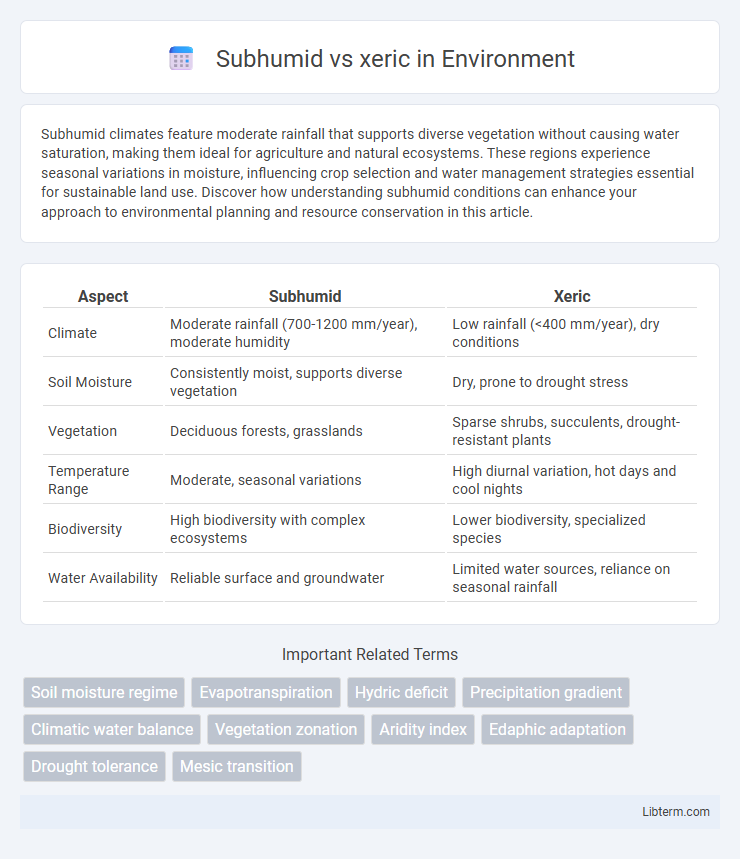Subhumid climates feature moderate rainfall that supports diverse vegetation without causing water saturation, making them ideal for agriculture and natural ecosystems. These regions experience seasonal variations in moisture, influencing crop selection and water management strategies essential for sustainable land use. Discover how understanding subhumid conditions can enhance your approach to environmental planning and resource conservation in this article.
Table of Comparison
| Aspect | Subhumid | Xeric |
|---|---|---|
| Climate | Moderate rainfall (700-1200 mm/year), moderate humidity | Low rainfall (<400 mm/year), dry conditions |
| Soil Moisture | Consistently moist, supports diverse vegetation | Dry, prone to drought stress |
| Vegetation | Deciduous forests, grasslands | Sparse shrubs, succulents, drought-resistant plants |
| Temperature Range | Moderate, seasonal variations | High diurnal variation, hot days and cool nights |
| Biodiversity | High biodiversity with complex ecosystems | Lower biodiversity, specialized species |
| Water Availability | Reliable surface and groundwater | Limited water sources, reliance on seasonal rainfall |
Understanding Subhumid and Xeric Climates
Subhumid climates are characterized by moderate moisture levels, supporting diverse vegetation and agriculture, while xeric climates experience low precipitation and high evapotranspiration, resulting in arid conditions. Subhumid regions typically exhibit seasonal rainfall patterns with annual precipitation ranging between 500 to 1000 millimeters. Xeric zones, often found in deserts or dry shrublands, maintain sparse vegetation adapted to water scarcity and extreme temperature variations.
Key Characteristics of Subhumid Regions
Subhumid regions are characterized by moderate rainfall, typically ranging from 500 to 1000 millimeters annually, supporting diverse vegetation including mixed forests and grasslands. Soil moisture in subhumid areas remains sufficient for crop growth without extensive irrigation, promoting sustainable agriculture. These climates experience balanced temperature variations, neither too dry nor excessively wet, providing favorable conditions for a variety of plant and animal species.
Defining Features of Xeric Environments
Xeric environments are characterized by extremely low moisture levels, sparse vegetation adapted to drought conditions, and soils that often exhibit high salinity or poor water retention. These regions typically experience high temperatures, minimal precipitation below 250 mm annually, and intense solar radiation that limits the growth of flora and fauna. Unlike subhumid areas, xeric zones have plants with specialized adaptations such as deep root systems, waxy leaf coatings, and efficient water storage mechanisms that enable survival in arid conditions.
Climate Patterns: Subhumid vs Xeric
Subhumid climates experience moderate rainfall, typically ranging from 500 to 1000 mm annually, supporting diverse vegetation and seasonal variations with warm summers and mild winters. Xeric climates are characterized by low precipitation, often below 300 mm per year, resulting in arid conditions with sparse vegetation adapted to drought and extreme temperature fluctuations. These contrasting climate patterns influence soil moisture availability, ecosystem types, and agricultural potential in subhumid versus xeric regions.
Soil and Vegetation Differences
Subhumid soils typically exhibit higher moisture retention and organic matter content, supporting dense, diverse vegetation such as mixed forests and tall grasses. Xeric soils are characterized by low moisture availability and often have sandy or rocky textures, resulting in sparse, drought-resistant vegetation like cacti, succulents, and hardy shrubs. These differences in soil moisture and composition fundamentally influence plant adaptations and ecosystem productivity in each environment.
Water Availability in Each Climate
Subhumid climates experience moderate water availability with annual precipitation ranging between 500 to 1000 millimeters, supporting diverse vegetation and moderate soil moisture. Xeric climates exhibit extremely limited water availability, receiving less than 300 millimeters of annual precipitation, resulting in sparse vegetation and highly arid soil conditions. Water availability directly influences ecosystem resilience, plant species composition, and agricultural potential in these distinct climatic zones.
Biodiversity: A Comparative Overview
Subhumid regions support higher biodiversity due to moderate rainfall and stable moisture levels that sustain diverse plant and animal species. Xeric environments, characterized by low precipitation and extreme temperatures, host specialized and drought-resistant species adapted to harsh conditions. The contrast in moisture availability drives distinct ecological communities, influencing species richness and ecosystem function in each biome.
Human Adaptation to Subhumid and Xeric Zones
Human adaptation to subhumid zones involves developing agricultural practices suited for moderate rainfall and seasonal variations, such as rain-fed farming and crop diversification to maintain soil fertility. In xeric zones, adaptations include water conservation techniques, use of drought-resistant crops, and construction of infrastructure like qanats or wells to access scarce water resources. Settlement patterns in xeric areas often reflect nomadic lifestyles or clustered communities centered around reliable water sources to cope with extreme aridity.
Agricultural Practices and Challenges
Subhumid regions with moderate rainfall support diverse crop cultivation, allowing farmers to implement crop rotation and intercropping techniques to maintain soil fertility and reduce pests. Xeric environments face challenges such as limited water availability and poor soil quality, necessitating drought-resistant crop varieties and water conservation methods like drip irrigation and rainwater harvesting. Sustainable agricultural practices in both zones require adapting to climate variability to enhance productivity and minimize land degradation.
Ecological Impacts and Conservation Strategies
Subhumid ecosystems, characterized by moderate moisture availability, support diverse plant and animal species that rely on consistent water sources, whereas xeric environments endure prolonged droughts, fostering specialized drought-resistant flora and fauna. Ecological impacts in subhumid areas include higher biodiversity but increased vulnerability to invasive species and habitat fragmentation, while xeric zones face challenges such as soil erosion and limited species adaptability. Conservation strategies in subhumid regions emphasize habitat restoration and water management, whereas xeric ecosystems require protection of native drought-adapted species and erosion control measures to maintain ecological balance.
Subhumid Infographic

 libterm.com
libterm.com